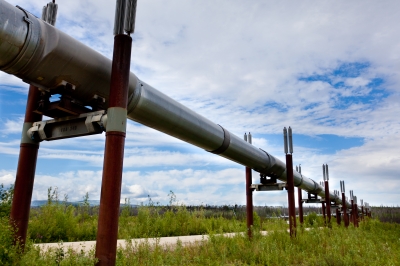Alaska’s Shady Secret Natural Gas Pipeline Deal Moving Quietly Ahead Behind Closed Doors

(EnviroNews Alaska) — Point Thomson, Alaska — Under a cloak of secrecy, and with little opposition from conservation groups, the potentially lucrative Alaska Liquefied Natural Gas (LNG) Pipeline project continues to build momentum under a new Governor.
The LNG Pipeline project is designed to move natural gas from the North Slope region along the Beaufort Sea, 800 miles to a treatment plant in Nikiski on the Kenai Peninsula. The gas would then be supercooled into a liquid (in a liquefaction process, the gas is superchilled to minus 260 degrees Fahrenheit). The gas would be loaded aboard tankers and shipped to buyers — most likely in Asia.
Alaska’s Governor Bill Walker, sworn in on Monday, Dec. 1, had criticized Governor Sean Parnell and his administration for keeping too much information regarding the LNG pipeline project confidential –but it seems he has backed off on his position.
Before Walker was sworn in as Alaska’s 11th governor since statehood, legislators and other officials were updated on the LNG Pipeline project by members of the Legislative Budget and Audit Committee on Friday, Nov. 28.
According to Alaska Dispatch News, 40 individuals signed confidentiality agreements, 20 of which were among the state’s 60 lawmakers. Sen. Mike Dunleavy, R-Wasilla, Sen. John Coghill, R-North Pole, and Rep. Bob Herron, D-Bethel, were on the roster of legislators who signed the secrecy agreement and attended the meetings.
There was a public hearing on Nov. 28 along with two executive sessions that lasted more than two hours, the Alaska Dispatch reported. The two closed-door sessions included details about the state’s bargaining position relative to other partners in the project like ExxonMobil, BP, ConocoPhillips and TransCanada (a Calgary-based pipeline company) as well as potential gas buyers.
Alaska State Representative Sam Kito III said: “There are definitely times and situations in the LNG Project development process that we will encounter the necessity to sign confidentiality agreements. In the case of the LNG Project, the state is a partner along with TransCanada, and the big three oil companies. During contract negotiations, it is important that all parties agree not to share confidential, financial information outside of the partners considering the project,” he said.
“I am of the opinion that signing the confidentiality agreement, and reviewing the contract to this point, does not move the project, or the state forward. I will be interested in receiving a project update when the Department of Natural Resources is under new leadership, and may very well consider signing a confidentiality agreement to participate in the discussion at that time,” he added. Kito did not sign the agreement or attend the meetings.
The LNG Pipeline project will cost an estimated between $45 billion and $65 billion (in 2012 dollars). The project is currently in the pre-front-end engineering and design (pre-FEED) stage, in which initial design, technical, environmental and commercial work is done. This $400-$500 million stage is expected to last through 2015.
On Nov., 21, 2014, the U.S. Department of Energy approved the project for LNG export. According to Alaska Dispatch News, Federal pipeline coordinator Larry Persily said that more significant than the go-ahead order, was the relatively little opposition the department received related to the project’s export license application.
The Department of Energy received a meager 27 comments by the Nov. 17 deadline. Of the comments, only one raised relevant objections, while more than 20 were supportive, according to the project’s web site.
The response was significantly less than what the department had received on multiple applications for LNG export projects in the Lower 48 states in recent years, the DOE reported on its web site.
The Sierra Club protested the Alaska LNG application in a filing, that states: “The proposed export project will cause extensive environmental harm, impacting the environment around the export site, inducing harmful natural gas production, and likely increasing global greenhouse gas emissions.”
In its motion to intervene, the Sierra Club wrote: “The global impact of investing in long-lived fossil fuel infrastructure it is likely that LNG exports will compete against wind, solar and other clean, renewable energy sources.”
So far, the Department of Energy has rejected the Sierra Club’s efforts to block LNG exports.
According to an Alaska Journal of Commerce report, more than 255 people participated in more than $30 million worth of fieldwork on the project during the 2014 season, and there are about 130 people working at offices in Anchorage, Houston and Calgary, Alberta on the plan to export liquefied North Slope gas. Based on the current estimated timeline, the first gas is expected to roll out sometime in 2024.
Governor Walker hinted at the forward momentum of the project in his inauguration speech: “Today, oil is hovering around $70 a barrel. We’re heading into some lean times. There is no reason we cannot turn that around. We live in one of the most resource-rich states in one of the wealthiest countries in the world. However, the key to every growing economy is low-cost energy. Alaska is rich in resources. We don’t have a resource problem. We have a distribution problem. I am steadfastly committed to delivering natural gas to Alaskans and to the lucrative global markets.”
Walker faces a budget deadline of Dec. 15. How the project will move forward now will be largely determined by the funds allocated by the Governor’s Office.
FILM AND ARTICLE CREDITS
- Suzanne Ashe - Research Journalist, Author



